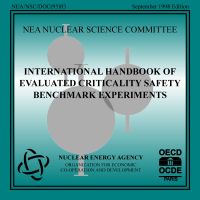
|
International Criticality Safety Benchmark Evaluation Project |

|

|
International Criticality Safety Benchmark Evaluation Project |

|
 The International Handbook of Evaluated Criticality Safety Benchmark Experiments was prepared by a working group comprised of experienced criticality safety personnel from the United States, the United Kingdom, Japan, the Russian Federation, France, Hungary, Korea, and Slovenia. The handbook contains criticality safety benchmark specifications that have been derived from experiments that were performed at various nuclear critical facilities around the world. The benchmark specifications are intended for use by criticality safety engineers to validate calculational techniques used to establish minimum subcritical margins for operations with fissile material. The example calculations presented do not constitute a validation of the codes or cross section data.
The International Handbook of Evaluated Criticality Safety Benchmark Experiments was prepared by a working group comprised of experienced criticality safety personnel from the United States, the United Kingdom, Japan, the Russian Federation, France, Hungary, Korea, and Slovenia. The handbook contains criticality safety benchmark specifications that have been derived from experiments that were performed at various nuclear critical facilities around the world. The benchmark specifications are intended for use by criticality safety engineers to validate calculational techniques used to establish minimum subcritical margins for operations with fissile material. The example calculations presented do not constitute a validation of the codes or cross section data.
The handbook contains 229 evaluations with benchmark specifications for 1684 critical or near critical configurations. Experiments that are found unacceptable for use as criticality safety benchmark experiments are discussed in the handbook evaluations; however, benchmark specifications are not derived for such experiments. A total of 310 experimental configurations are categorized as unacceptable for use as criticality safety benchmark experiments. Additional evaluations are in progress and will be added to the handbook periodically.
The online version of the ICSBEP handbook is in Adobe PDF format.
The online version of the ICSBEP handbook was designed to function as close as possible to the CD version. (You may request a CD-ROM by completing the CD-ROM Request Form.) Navigation is accomplished using links within the PDF documents. Since the Adobe plug-in does not include a search button on its toolbar, a navigation bar providing search capability is included at the bottom of the browser window. This means that you must be using a browser that is capable of handling frames.
And finally, access to the ICSBEP Handbook is restricted and a password is required.
If you already have a password, you may
enter.
Otherwise, you will need to request a password from daho National Engineering & Environmental Laboratory.